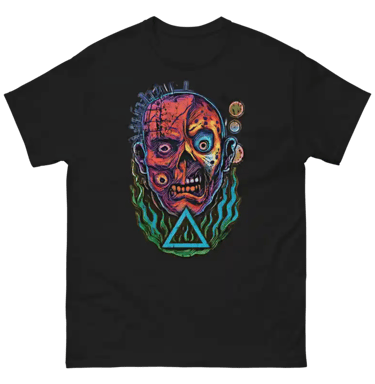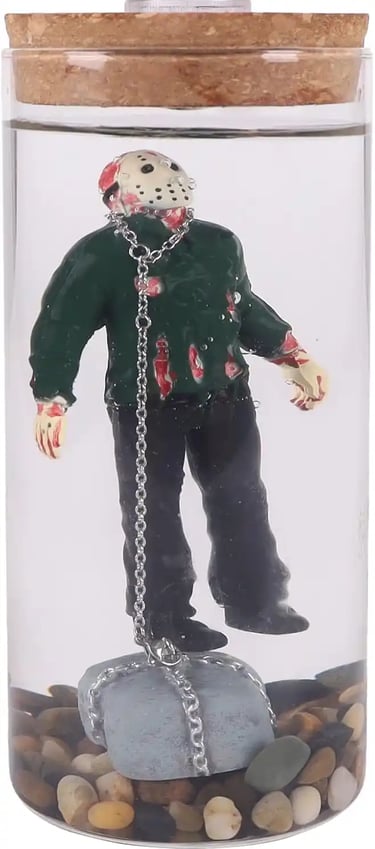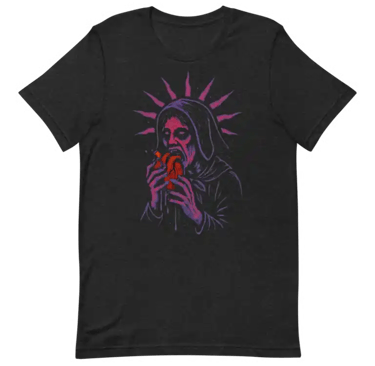Classic Horror Icons: 5 Films Reviewed
Explore 5 classic horror icons in depth—Hellraiser, Friday the 13th, Elm Street, Child’s Play, and Phantasm—in a dark review of their occult legacy and power.
HORROR REVIEWS
Marcel Helmar
10/22/20257 min read
CAPTION: Five icons, one occult legacy — Hellraiser, Friday the 13th, Elm Street, Child’s Play, and Phantasm converge in a ritual of horror cinema.
The Invocation
Horror as Ritual, Cinema as Sorcery
Horror films are not mere entertainment; they are modern grimoires, ritual texts encoded in celluloid. To watch them is to participate in a rite, to be initiated into a mythology that predates the screen itself. The Classic Horror Icons of the late 70s and 80s — Pinhead, Jason, Freddy, Chucky, and the Tall Man — are not just characters but archetypes, masks of primal forces that have haunted humanity since the first whispered tales around firelight. Pain, hunger, vengeance, possession, transcendence: each of these films embodies one of these eternal currents, binding pop culture to the occult in ways both overt and subliminal.
These five films are not isolated curiosities of the VHS era. They are pillars of occult horror, each one a ritual mask that reveals a different face of the same abyss. To study them is to trace the outlines of a hidden liturgy — a cinema of sorcery that dares to show us what lies beneath the skin of reality.


The Nightmare Pantheon
Wear the Iconic 5 As 1 Mask of Horror
Unite Pinhead, Jason, Freddy, Chucky, and the Tall Man in one occult design. This exclusive shirt is a wearable grimoire for true initiates of horror.
$22.50
I. Hellraiser (1987)
The Cenobites and the Black Flame
Clive Barker’s Hellraiser is not a slasher, not a haunted house, not even a conventional demon story. It is a ritual text masquerading as horror cinema. The Cenobites are not “monsters” in the traditional sense but archons of the demiurge — enforcers of a cosmic order that thrives on pain, sensation, and the collapse of boundaries between pleasure and torment. They are priests of the Black Flame, emissaries of a prison‑planet theology where flesh is both altar and offering.
At the center of this ritual is the Lament Configuration, a puzzle box that functions as a modern Babylonian grimoire. To solve it is to summon forbidden hierarchies, to invite transformation through exquisite suffering. This is the Ritual of the Archon: the summoning of powers beyond comprehension, not for salvation but for transcendence through torment.
What makes Hellraiser endure is its unapologetic esotericism. It dares to go deeper than gore, presenting horror as a form of initiation. Barker’s vision is surreal, erotic, and occult — a reminder that true horror is not about death, but about what happens when the boundaries of flesh and spirit are torn open.
II. Friday the 13th (1980)
Jason as Necromantic Golem
Jason Voorhees is not merely a slasher villain; he is a revenant, a golem sculpted from grief and vengeance. His mother’s will animates him, her rage binding him to the lake like a curse that refuses to dissolve. The waters of Crystal Lake are not just a backdrop — they are a ritual mirror, a liminal surface where death and rebirth collapse into one.
This is the Ritual of Necromancy: resurrection through black magic, vengeance as the animating force. Jason’s hulking, silent form is less a man than a vessel — a corpse‑golem animated by maternal devotion twisted into wrath. His cracked hockey mask becomes a funerary relic, a sigil of undeath.
What makes Friday the 13th endure is its grounding in the familiar. Summer camps, lakes, teenage rituals of freedom — all corrupted by the intrusion of necromantic horror. It is horror that feels imminent, personal, and inevitable: the dead will not stay buried when grief itself is the summoner.


Jason Voorhees Horror Water Lamp
Bring Crystal Lake's Curse to Your Lair
Summon the spirit of Camp Crystal Lake with this eerie Jason Voorhees water lamp. A perfect collector’s piece that fuses horror décor with occult ambiance.
$36.99 - Amazon
III. A Nightmare on Elm Street (1984)
Freddy the Dream‑Demon Occultist
Freddy Krueger is not just a killer in a striped sweater; he is an occultist of the astral plane, a pact‑maker who has mastered the art of lucid dreaming and transformed himself into a demon of nightmares. His scarred flesh is the mark of his mortal death, but his true body is woven from dreamstuff and terror.
The dream‑realm is the most intimate hellscape. No one escapes sleep; everyone is vulnerable. Freddy’s genius is not in his claws but in his ritual mastery of the astral, where he bends the subconscious into a killing ground. This is the Ritual of the Dream Sorcerer: the transformation of the self into a predator of the psyche.
Elm Street proves that horror does not need physical proximity to terrify. Freddy invades the one sanctuary no one can avoid — the mind at rest. In doing so, he elevates horror into the metaphysical, showing us that terror is not bound by walls, locks, or waking life.
IV. Child’s Play (1988)
Chucky and the Black Magic of Possession
Charles Lee Ray is not a clownish slasher trapped in a doll; he is an adept of transference, a sorcerer who has mastered the black art of soul migration. His dying breath is not surrender but invocation, channeling his essence into the plastic shell of a child’s toy.
The doll becomes a corrupted familiar, innocence inverted into horror. This is the Ritual of Possession: the inhabitation of vessels, the desecration of the domestic sphere. Chucky’s grin is not just uncanny — it is a mockery of childhood itself, a reminder that even the most mundane object can become a haunted reliquary.
Child’s Play unsettles because it brings the occult into daylight. The horror is not confined to graveyards or dreamscapes; it sits in the living room, in the toy chest, in the hands of a child. It is horror that invades the ordinary, proving that black magic does not need shadows to thrive.
V. Phantasm (1979)
The Tall Man and the Interdimensional Warlock
The Tall Man is not a mere undertaker; he is a realm‑walker, a necromancer trafficking in souls across dimensions. His mortuary is a gateway, his silver spheres demonic servitors that harvest flesh and spirit alike.
Phantasm operates on dream logic, its narrative bending and warping like a fever vision. This is not incoherence but occult cosmology — a glimpse into the machinery of interdimensional sorcery. The Tall Man embodies the Ritual of the Realm‑Walker: mastery of portals, dominion over death, and the trafficking of souls between planes.
What makes Phantasm endure is its refusal to explain itself. It is horror as gnosis, a revelation that reality itself is porous, unstable, and haunted by forces that do not obey human logic. The Tall Man is less a villain than a cosmic principle: death as commerce, eternity as conquest.
Closing Incantation
Five Masks, One Ritual
Taken together, these five films form a pantheon of occult archetypes:
The Archon Ritual (Hellraiser)
The Necromancy Ritual (Friday the 13th)
The Dream Sorcery Ritual (Elm Street)
The Possession Ritual (Child’s Play)
The Realm‑Walker Ritual (Phantasm)
They are not isolated stories but modern mythic masks of the same primal forces. Horror cinema is a ritual mirror: it does not merely scare, it reveals. Pain, hunger, vengeance, possession, transcendence — these are not just themes, they are initiations.
To watch these films is not escapism. It is initiation. They are not just viewed; they are endured, absorbed, and carried like curses. The Classic Horror Icons are not characters on a screen — they are masks of the abyss, and when we gaze into them, they gaze back.
How to Read Horror as Ritual
Step 1 — Choose the Classic Horror Icons Begin with the five pillars: Hellraiser, Friday the 13th, A Nightmare on Elm Street, Child’s Play, and Phantasm. These are not just films, but ritual masks of pain, vengeance, possession, and transcendence.
Step 2 — Identify the Archetype Each film encodes a ritual: the Archon (Hellraiser), Necromancy (Friday the 13th), Dream Sorcery (Elm Street), Possession (Child’s Play), and Realm‑Walking (Phantasm). Recognize the archetype before the gore.
Step 3 — Read the Symbols as Sigils The puzzle box, the lake, the striped sweater, the doll, the mortuary spheres — these are not props, but sigils. Treat them as ritual objects encoded in cinema.
Step 4 — Connect the Rituals See the films not as isolated stories but as chapters of one occult grimoire. Together, they form a pantheon of horror that mirrors primal forces.
Step 5 — Carry the Initiation Do not dismiss them as escapism. Horror cinema is initiation. To watch is to endure, to absorb, to carry the curse forward.
Frequently Asked Questions
Q: Who are considered the Classic Horror Icons in this review?
A: This article focuses on five pillars of occult horror: Hellraiser (Pinhead and the Cenobites), Friday the 13th (Jason Voorhees), A Nightmare on Elm Street (Freddy Krueger), Child’s Play (Chucky), and Phantasm (the Tall Man). Each embodies a ritual archetype that transcends the screen.
Q: Why are these films described as “occult horror” instead of just slashers or thrillers?
A: Because each film encodes ritual archetypes — pain as transcendence, necromancy, dream sorcery, possession, and interdimensional war. They are not just stories but modern grimoires, cinematic rituals that reveal primal forces.
Q: How does this article differ from a standard horror movie review?
A: Instead of surface‑level summaries, this review treats horror cinema as ritual text. It interprets each film as a mask of mythic archetypes, positioning them as part of a larger occult pantheon rather than isolated franchises.
Q: Do I need to have seen all five films to understand the analysis?
A: No. The essay is written to stand on its own, offering context for each film while drawing out the deeper archetypal and ritual themes. Watching the films will enrich the experience, but the analysis is designed as initiation, not homework.
Q: Why are images limited in this article compared to other horror blogs?
A: Horror & Hexes emphasizes atmosphere, speed, and ritual cadence. A single featured image, merch visuals, and carefully chosen ads are enough to set the tone without sacrificing page performance or overwhelming the text.
Q: What makes these Classic Horror Icons still relevant today?
A: Because they embody timeless archetypes. Pain, vengeance, possession, and transcendence are not bound to the 80s — they are eternal forces. These films endure because they channel something older than cinema itself.
Join Us
Join the Coven: a small, ritual-minded newsletter that arrives like a folded note—short, strange, and useful. Subscribe and get an immediate 10% off code for your first purchase, plus access to early drops, behind-the-scenes ritual notes, and curated occult finds.
About the Author:
Marcel Helmar is a cinematic occult artist, writer, and founder of Horror & Hexes. His work blends ritual symbolism, folk horror, and studio‑grade printmaking to produce limited art drops, immersive essays, and practical ritual guides.
Marcel’s writing and visual practice have been used by filmmakers, podcasters, and indie publishers to create atmosphere and authenticity; he teaches workshops on image making, lore research, and publishing for dark‑culture creators. Visitors can browse his gallery, read deep‑dive essays, or join the mailing list for exclusive drops and process notes.
Connect
Explore dark tales and ritualistic mysteries here.
Support
+1-337-718-0155
© 2025. All rights reserved.
Flesh Catechism T-Shirt
Eat Your Heart Out
$22.50

